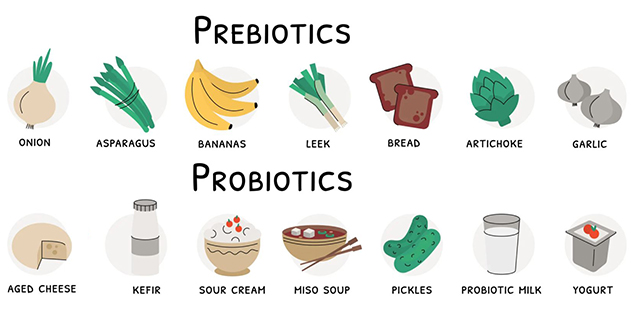MICROBIOME LINGO: PREBIOTICS, PROBIOTICS AND SYNBIOTICS

Our microbiome is a collection of around 100 trillion bacteria (mostly), fungi and viruses that live both on the surface of our body’s and inside our gastrointestinal tract – from mouth to anus. A typical adult’s microbiome weighs around 1 kilogram, equivalent to some of our essential organs. Believe it or not, there are about 10 times more bacteria in our microbiome than there are cells in our body, or put another way, 90% of the cells in our bodies are microbial and only the remaining 10% are human!
Our understanding of what exactly constitutes a healthy microbiome is evolving rapidly, and at this point in time, we don’t have clear definition of a healthy gut microbiome based on microbial composition. We do think that the greater the diversity in species the better and that the balance among the different species in our gastrointestinal tract is important.
- Prebiotics: help the beneficial microbes that already existing within our microbiome to increase in number (and proportion) by providing them with the nutrients they need, and
- Probiotics: add living beneficial microbes directly to our foods and beverages.
Prebiotics
Are defined as “a substrate that is selectively utilized by host microorganisms conferring a health benefit”.
Most substrates are specific kinds of dietary fibres that serve as nutrients for beneficial microorganisms harboured by the host, including indigenous (resident) microorganisms and administered probiotic strains. Therefore, prebiotics differ from most dietary fibres such as pectins, cellulose and xylans, which encourage growth of a wide variety of gut microorganisms. In other words, a prebiotic should not be broadly metabolized, but elicit a metabolism biased towards health-promoting microorganisms within the individual’s ecosystem.
The known health benefits of prebiotics are evolving but currently include benefits to the gastrointestinal tract (e.g., inhibition of pathogens, immune stimulation), cardiometabolism (e.g., reduction in blood cholesterol levels, effects upon insulin resistance), mental health (e.g., metabolites that influence brain function, energy and cognition) and bone health (e.g., mineral bioavailability), among others.
Probiotics
Are defined as “live microorganisms that, when administered in adequate amounts, confer a health benefit on the host”.
There is a core group of well-studied species that are likely to impart some general health benefits, when delivered in food at a level of 1,000,000,000 (109) colony forming units (CFU) per serving as probiotics. These are Bifidobacterium (adolescentis, animalis, bifidum, breve and longum) and Lactobacillus (acidophilus, casei, fermentum, gasseri, johnsonii, paracasei, plantarum, rhamnosus and salivarius) bacteria.
The general benefit of probiotics on the gut microbiome derives from them creating a more favourable gut environment, through mechanisms shared by most probiotics. They include:
- Colonization resistance
- Acid and short chain fatty acid production
- Regulation of intestinal transit
- Normalization of disturbed microbiota
- Increased turnover of intestinal cells (enterocytes)
- Competitive exclusion of pathogens (e.g., pathogenic bacteria, fungi or viruses)
Some specific species may provide additional benefits, including:
- Gut barrier reinforcement
- Vitamin synthesis
- Neutralization of carcinogens
Synbiotics
Are defined as “a mixture comprising live microorganisms and substrate(s) selectively utilized by host microorganisms that confers a health benefit on the host”.
Host’ microorganisms in this context include both autochthonous or indigenous microorganisms (resident or already colonizing the host) and allochthonous microorganisms (externally applied, such as probiotics), which, even if transiently present, do constitute a component of the host microbiota.
There are two different kinds of synbiotics:
- A ‘synergistic synbiotic’ is a synbiotic in which the substrate is designed to be selectively utilized by the co- administered microorganism(s).
- A ‘complementary synbiotic’ is a synbiotic composed of a probiotic combined with a prebiotic, which is designed to target autochthonous microorganisms.
Foods and beverages are increasingly making claims that they contain prebiotics, probiotics and/or synbiotics, so keep these definitions in mind when shopping, so you can decide whether they are of any use to you.
Read more:
- Gibson and colleagues. The International Scientific Association for Probiotics and Prebiotics (ISAPP) consensus statement on the definition and scope of prebiotics. Nat Rev Gastroenterol Hepatol. 2020
- Hill and colleagues. Expert consensus document. The International Scientific Association for Probiotics and Prebiotics consensus statement on the scope and appropriate use of the term probiotic. Nat Rev Gastroenterol Hepatol. 2014
- Swanson and colleagues. The International Scientific Association for Probiotics and Prebiotics consensus statement on the definition and scope of synbiotics. Nat Rev Gastroenterol Hepatol. 2020

Dr Alan Barclay, PhD, is a consultant dietitian and chef with a particular interest in carbohydrates and diabetes. He is author of Reversing Diabetes (Murdoch Books), and co-author of 30-plus scientific publications, The Good Carbs Cookbook (Murdoch Books), Managing Type 2 Diabetes (Hachette Australia) and The Ultimate Guide to Sugars and Sweeteners (The Experiment Publishing).
Contact: Follow him on Twitter, LinkedIn or check out his website.







